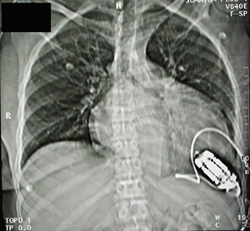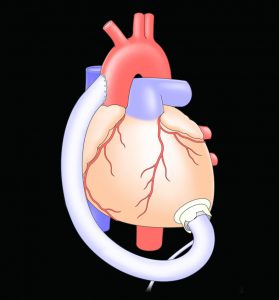 The surgical procedure to implant any medical device is shaped partly by the design of the device and partly by the methods employed by the surgeons who implant it. The Jarvik 2000 FlowMaker® is designed to be easy to implant, and clinical experience has confirmed that it is.
The surgical procedure to implant any medical device is shaped partly by the design of the device and partly by the methods employed by the surgeons who implant it. The Jarvik 2000 FlowMaker® is designed to be easy to implant, and clinical experience has confirmed that it is.
During surgery, the pump is placed inside the left ventricle through a circular incision in the heart wall and sewn into place. There the pump is secured with a polyester sewing cuff and joined via the outflow graft to the aorta, the main artery that carries blood to the rest of the body. The surgeon then routes the power cable either through the abdominal wall or under the skin to a pedestal mounted on the head behind the ear, depending on whether the pump is being implanted permanently or as a bridge to transplant.
Before the pump is activated, all air is evacuated from the device, the left ventricle and the aorta. The pump is switched on, and if cardiopulmonary bypass was used, the patient is weaned from the heart-lung bypass machine. Due to the small size of the device and less invasive surgery, the Jarvik 2000 also can be successfully implanted without the use of a heart-lung bypass machine. See Off-pump Insertion of the Jarvik 2000 Left Ventricular Assist Device, by Craig H. Selzman, MD. The CardioThoracic Surgery Network, February 21, 2008.
 Even before the incisions are closed, the Jarvik 2000 goes to work moving blood through the heart and restoring a physiologic equilibrium to the body. The implantation process usually takes 2-5 hours.
Even before the incisions are closed, the Jarvik 2000 goes to work moving blood through the heart and restoring a physiologic equilibrium to the body. The implantation process usually takes 2-5 hours.
As with open heart surgery of any kind, there are risks, including death. Each patient should discuss possible risks and benefits with his/her own doctor before deciding what treatment is best.
Jarvik 2000: evolution of surgical implantation from conventional to minimally invasive technique


You must be logged in to post a comment.